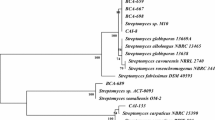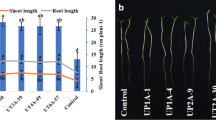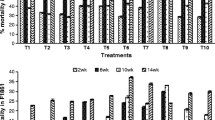Abstract
Four treatments applied on potato seed tubers i.e. talc only, chitosan only, Streptomyces melanosporofaciens strain EF-76 in talc and S. melanosporofaciens strain EF-76 in chitosan were compared for their efficiency to reduce common scab incidence. As previously reported the joint application of the geldanamycin-producing S. melanosporofaciens strain EF-76 and chitosan was effective to control common scab of potato. Nevertheless, field application of S. melanosporofaciens EF-76 did not allow the selection of geldanamycin-resistant actinomycetes (GRA) in the bulk soil during the potato growing season. The number of GRA on harvested potato tubers was, however, significantly higher in treatments that contained chitosan than in other treatments suggesting that chitosan might promote the establishment of the antagonistic actinomycete on progeny tubers. Biolog EcoPlates were used to determine the metabolic profiles of the bacterial soil communities. A permutation MANOVA analysis detected significant differences within the metabolic profiles of the bacterial communities at the potato flowering period but not at the beginning of the season or a week before harvest. A combination of S. melanosporofaciens EF-76 and chitosan thus represents a promising tool against common scab, with low short-term impact on soil bacterial communities.
Similar content being viewed by others
References
Adams M.J. and Lapwood D.H. (1978). Studies on the lenticel development, surface microflora and infections by common scab (Streptomyces scabies) of potato tubers growing in wet and dry soils. Ann. Appl. Biol. 90: 335–343
Agbessi S., Beauséjour J., Déry C. and Beaulieu C. (2003). Antagonistic properties of two recombinant strains of Streptomyces melanosporofaciens obtained by intraspecific protoplast fusion. Appl. Microbiol. Biotechnol. 62: 233–238
Beauséjour J., Clermont N. and Beaulieu C. (2003). Effect of Streptomyces melanosporofaciens strain EF-76 and of chitosan on common scab of potato Plant Soil 256: 463–468
Benhamou N., Lafontaine P.J. and Nicole M. (1994). Induction of systemic resistance to Fusarium Crown and root rot in tomato plants by seed treatment with chitosan. Phytopathology 84: 1432–1444
Benhamou N. and Thériault G. (1992). Treatment with chitosan enhances resistance of tomato plants to the crown and root rot pathogen, Fusarium oxysporum f. sp. radicis-lycopersici. Physiol. Mol. Plant. Pathol. 41: 33–52
Bjorklof K., Sen R. and Jorgensen K.S. (2003). Maintenance and impacts of an inoculated mer/luc-tagged Pseudomonas fluorescens on microbial communities in birch rhizospheres developed on humus and peat. Microb. Ecol. 45: 39–52
Bouchek-Mechiche K., Pasco C., Andrivon D. and Jouan B. (2000). Differences in host range, pathogenicity to potato cultivars and response to soil temperature among Streptomyces species causing common and netted scab in France. Plant Pathol. 49: 3–10
Davis J.R., McMaster G.M., Callihan R.H., Garner J.G. and McDole R.E. (1976). The relationship of irrigation timing and soil treatments to control potato scab. Phytopathology 64: 1404–1410
DeBoer C., Meulman P.A., Wnuk R.J. and Peterson D.H. (1970). Geldanamycin, a new antibiotic. J. Antibiotics 23: 442–447
Doumbou C.L., Akimov V. and Beaulieu C. (1998). Selection and characterization of microorganisms utilizing thaxtomin A, a phytotoxin produced by Streptomyces scabies. Appl. Environ. Microbiol. 64: 4313–4316
Doumbou C.L., Akimov V., Côté M., Charest P.-M. and Beaulieu C. (2001). Taxonomic study on nonpathogenic streptomycetes isolated from common scab lesions on potato tubers. Syst. Appl. Microbiol. 24: 451–456
Ellis R.J., Thompson I.P. and Bailey M.J. (1995). Metabolic profiling as a means of characterizing plant-associated microbial communities. FEMS Microbiol. Ecol. 16: 9–18
Faucher E., Savard T. and Beaulieu C. (1992). Characterization of actinomycetes isolated from common scab lesions on potato tubers. Can. J. Plant Pathol. 14: 197–202
Garland J.L. (1997). Analysis and interpretation of community-level physiological profiles in microbial ecology. FEMS Microbiol. Ecol. 24: 289–300
Garland J.L. and Mills A.L. (1991). Classification and characterization of heterotrophic microbial communities on the basis of patterns of community-level sole-carbon- source utilization. Appl. Environ. Microbiol. 57: 2351–2359
Goyer C., Otrysko B. and Beaulieu C. (1996). Taxonomic studies on streptomycetes causing potato common scab: a review. Can. J. Plant Pathol. 18: 107–113
Helander I.M., Nurmiaho-Lassila E.-L., Ahvenainen R., Rhoades J. and Roller S. (2001). Chitosan disrupts the barrier properties of the outer membrane of Gram-negative bacteria. Int. J. Food Microbiol. 71: 235–244
Jobin, G., G. Couture, C. Goyer, R. Brzezinski and C. Beaulieu, 2005. Streptomyces spores entrapped in chitosan beads as novel biocontrol tool against common scab. Appl. Microbiol. Biotechnol. 68: 104–108.
Kauss H., Jenlick W. and Domard A. (1989). The degrees of polymerization and N-acetylation of chitosan determine its ability to elicit callose formation in suspension cells and protoplasts of Catharanthus roseus. Planta 178: 385–392
Labrie C., Leclerc P., Côté N., Roy S., Brzezinski R., Hogue R. and Beaulieu C. (2001). Effect of chitin waste-based composts produced by two-phase composting on two oomycete plant pathogens. Plant Soil 235: 27–34
Lambert D.H. and Loria R. (1989). Streptomyces scabies sp. nov., nom. rev. Int. J. Syst. Bacteriol. 39: 387–392
Li H., Parent L.É., Tremblay C. and Karam A. (1999). Potato response to crop sequence and nitrogen fertilization sod breakup in a Gleyed Humo-Ferric Podzol. Can. J. Plant. Sci. 79: 439–446
Liu D., Anderson N.A. and Kinkel L.L. (1995). Biological control of potato scab in the field with antagonistic Streptomyces scabies. Phytopathology 85: 827–831
Lottmann J., Heuer H.J., De Vries J., Mahn A., Düring K., Wackernagel W., Smalla K. and Berg G. (2000). Establishment of introduced antagonistic bacteria in the rhizosphere of transgenic potatoes and their effect on the bacterial community. FEMS Microbiol. Ecol. 33: 41–49
Manly B.F.J. (1997). Randomization, Bootstrap and Monte Carlo Methods in Biology. Chapman & Hall, London, England, 399
Miethling R., Wieland G., Backhaus H. and Tebbe C.C. (2000). Variation of microbial rhizosphere communities in response to crop species, soil origin, and inoculation with Sinorhizobium meliloti L33. Microb. Ecol. 40: 43–56
Natsch A., Keel C., Hebecker N., Laasik E. and Défago G. (1998). Impact of Pseudomonas fluorescens strain CHA0 and a derivative with improved biocontrol activity on the culturable resident bacterial community on cucumber roots. FEMS Microbiol. Ecol. 27: 365–380
Pesarin F. (2001). Multivariate Permutation Tests with Applications in Biostatistics. John Wiley & Sons, New York, USA, 408
Pridham T.G., Anderson P., Foley C., Lindenfelser L.A., Hessetine C.W. and Benedict R.G. (1956–57). A selection of media for maintenance and taxonomic study of Streptomyces. Antibiotics Annu. 1956-57: 947–953
Ryan A.D. and Kinkel L.L. (1997). Inoculum density and population dynamics of suppressive and pathogenic Streptomycesstrains and their relationship to bacterial control of potato scab. Biol. Control 10: 180–186
Ryan A.D., Kinkel L.L. and Schottel J.C. (2004). Effect of pathogen isolate, potato cultivar, and antagonist strain on potato scab severity and biological control. Biocontrol Sci. Technol. 14: 301–311
Schwieger F. and Tebbe C.C. (2000). Effect of field inoculation with Sinorhizobium meliloti L33 on the composition of bacterial communities in rhizospheres of a target plant (Medicago sativa) and a non-target plant (Chenopodium album)-linking of 16S rRNA gene-based single-strand conformation polymorphism community profiles to the diversity of cultivated bacteria. Appl. Environ. Microbiol. 66: 3556–3565
Staddon W.J., Duchesne L.C. and Trevors J.T. (1997). Microbial diversity and community structure of postdisturbance forest soils as determined by sole-carbon-source utilization patterns. Microb. Ecol. 34: 125–130
Toussaint V., Valois D., Dodier M., Faucher E., Déry C., Brzezinski R., Ruest L. and Beaulieu C. (1997). Characterization of actinomycetes antagonistic to Phytophtora fragariae var. rubi, the causal agent of raspberry root rot. Phytoprotection 78: 43–51
Van Elsas J.D., Duarte G.F., Rosado A.S. and Smalla K. (1998). Microbiological and molecular biological methods for monitoring microbial inoculants and their effects in the soil environment. J. Microbiol. Methods 32: 133–154
Vahjen W., Munch J.C. and Tebbe C.C. (1995). Carbon source utilization of soil extracted microorganisms as a tool to detect the effect of soil supplemented with genetically engineered and non-engineered Corynebacterium glutamicum and a recombinant peptide at the community level. FEMS Microbiol. Ecol. 18: 317–328
Vruggink H. (1970). The effect of chitin amendment on actinomycetes in soil and on the infection of potato tubers by Streptomyces scabies. Neth. J. Plant Pathol. 76: 293–295
Zak J.C., Willig M.R., Moorhead D.L. and Wildman H.G. (1994). Functional diversity of microbial communities: a quantitative approach. Soil Biol. Biochem. 26: 1102–1108
Author information
Authors and Affiliations
Corresponding author
Rights and permissions
About this article
Cite this article
Prévost, K., Couture, G., Shipley, B. et al. Effect of chitosan and a biocontrol streptomycete on field and potato tuber bacterial communities. Biocontrol 51, 533–546 (2006). https://doi.org/10.1007/s10526-005-4240-z
Received:
Accepted:
Published:
Issue Date:
DOI: https://doi.org/10.1007/s10526-005-4240-z




